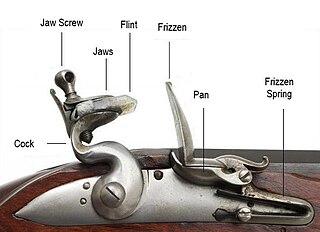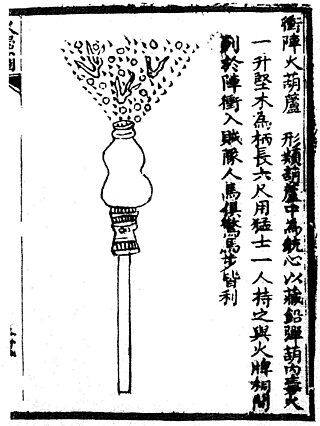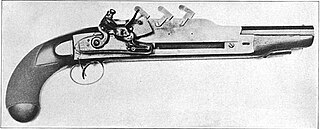
A firearm is any type of gun that uses an explosive charge and is designed to be readily carried and used by an individual. The term is legally defined further in different countries.

The percussion cap or percussion primer, introduced in the early 1820s, is a type of single-use percussion ignition device for muzzle loader firearm locks enabling them to fire reliably in any weather condition. Its invention gave rise to the cap lock mechanism or percussion lock system which used percussion caps struck by the hammer to set off the gunpowder charge in rifles and cap and ball firearms. Any firearm using a caplock mechanism is a percussion gun. Any long gun with a cap-lock mechanism and rifled barrel is a percussion rifle. Cap and ball describes cap-lock firearms discharging a single bore-diameter spherical bullet with each shot.

In firearms terminology, an action is the functional mechanism of a breech-loading firearm that handles the ammunition cartridges, or the method by which that mechanism works. Actions are technically not present on muzzleloaders, as all those are single-shot firearms with a closed off breech with the powder and projectile manually loaded from the muzzle. Instead, the muzzleloader ignition mechanism is referred to as the lock.

Flintlock is a general term for any firearm that uses a flint-striking ignition mechanism, the first of which appeared in Western Europe in the early 16th century. The term may also apply to a particular form of the mechanism itself, also known as the true flintlock, that was introduced in the early 17th century, and gradually replaced earlier firearm-ignition technologies, such as the matchlock, the wheellock, and the earlier flintlock mechanisms such as the snaplock and snaphaunce.

A matchlock or firelock is a historical type of firearm wherein the gunpowder is ignited by a burning piece of flammable cord or twine that is touched to the gunpowder by a mechanism that the musketeer activates by pulling a lever or trigger with their finger. This firing mechanism was an improvement over the hand cannon, which lacked a trigger and required the musketeer or an assistant to apply a match directly to the gunpowder by hand. The matchlock mechanism allowed the musketeer to apply the match himself without losing his concentration.

A snaphance or snaphaunce is a type of firearm lock in which a flint struck against a striker plate above a steel pan ignites the priming powder which fires the gun. It is the mechanical progression of the wheellock firing mechanism, and along with the miquelet lock and doglock are predecessors of the flintlock mechanism.

The flintlock mechanism is a type of lock used on muskets, rifles, and pistols from the early 17th to the mid-19th century. It is commonly referred to as a "flintlock". The term is also used for the weapons themselves as a whole, and not just the lock mechanism.

Miquelet lock is a modern term used by collectors and curators for a type of firing mechanism used in muskets and pistols. It is a distinctive form of snaplock, originally as a flint-against-steel ignition form, once prevalent in the Spanish, Portuguese, and Ottoman empires, Italy, North Africa, and the Balkans from the late 16th to the mid-19th century.

The lock of a firearm is the mechanism used to initiate firing. It is a historical term, in that it generally refers to such mechanisms used in muzzle-loading and early breech-loading firearms. Side-lock refers to the type of construction, in which the individual components of the mechanism are mounted either side of a single plate. The assembly is then mounted to the stock on the side of the firearm. In modern firearm designs, the mechanism to initiate firing is generally constructed within the frame or receiver of the firearm and is referred to as the firing or trigger mechanism.

A snaplock is a type of lock for firing a gun or is a gun fired by such a lock.

A touch hole, also known as a cannon vent, is a small hole at the rear (breech) portion of the barrel of a muzzleloading gun or cannon. The hole provides external access of an ignition spark into the breech chamber of the barrel, either with a slow match (matchlock), a linstock or a flash pan ignited by some type of pyrite- (wheellock) or flint-based gunlock, which will initiate the combustion of the main gunpowder charge. Without touch hole, it would be nearly impossible to ignite the powder because the only otherwise access into the barrel is from the front via the muzzle, which is obturated by the projectile.
The flash pan or priming pan is a small receptacle for priming powder, found next to the touch hole on muzzle-loading guns. Flash pans are found on gonnes, matchlocks, wheellocks, snaplocks, snaphances, and flintlocks.

The snap matchlock is a type of matchlock mechanism used to ignite early firearms. It was used in Europe from about 1475 to 1640, and in Japan from 1543 until about 1880, and was also largely used by Korea (Joseon) during the Imjin war to the early 20th century.

The frizzen, historically called the "hammer" or the steel, is an L-shaped piece of steel hinged at the front used in flintlock firearms. The frizzen is held in one of two positions, opened or closed, by a leaf spring. When closed, it is positioned over the flash pan so as to enclose a small priming charge of black powder next to the flash hole that is drilled through the barrel into which the main charge has been loaded. When the trigger is pulled, the cock, which holds a shaped piece of flint clamped in a set of jaws with a scrap of leather or thin piece of lead, snaps forward causing the flint to scrape downward along the frizzen's face, throwing it forward into the open position and exposing the priming powder. The flint scraping along the steel causes a shower of sparks to be thrown into the pan, thereby igniting the priming powder therein and sending flames through the touch hole, which in turn ignites the main charge of black powder in the breech of the barrel, driving the projectile out of the muzzle.

The hammer is a part of a firearm that is used to strike the percussion cap/primer, or a separate firing pin, to ignite the propellant and fire the projectile. It is so called due to the fact that it resembles a hammer in both form and function. The hammer itself is a metal piece that forcefully rotates about a pivot point.

A handgun is a firearm designed to be usable with only one hand. It is distinguished from a long gun which needs to be held by both hands and braced against the shoulder. Handguns have shorter effective ranges compared to long guns, and are much harder to shoot accurately. While most early handguns are single-shot pistols, the two most common types of handguns used in modern times are revolvers and semi-automatic pistols, although other handguns such as derringers and machine pistols also see infrequent usage.

The history of firearms begins in 10th-century China, when tubes containing gunpowder and pellet projectiles were mounted on spears to make portable fire lances, operable by one person. This was later used effectively as a shock weapon in the Siege of De'an in 1132. In the 13th century, fire lance barrels were replaced with metal tubes and transformed into metal-barreled hand cannons. The technology gradually spread throughout Eurasia during the 14th century and evolved into flintlocks, blunderbusses, and other variants. The 19th and 20th centuries saw an acceleration in this evolution, with the introduction of the magazine, belt-fed weapons, metal cartridges, and the automatic firearm. Older firearms typically used black powder as a propellant, but modern firearms use smokeless powder or other propellants. Most modern firearms have rifled barrels.

The Kalthoff repeater was a type of repeating firearm that was designed by members of the Kalthoff family around 1630, and became the first repeating firearm to be brought into military service. At least nineteen gunsmiths are known to have made weapons following the Kalthoff design. Some early Kalthoff guns were wheellocks, but the rest were flintlocks. The capacity varied between 5 and 30 rounds, depending on the style of the magazines. A single forward and back movement of the trigger guard, which could be done in 1–2 seconds, readied the weapon for firing. The caliber of Kalthoff guns generally varied between 0.4–0.8 in (10–20 mm), though 0.3 in (7.6 mm) caliber examples also exist.

A superposed load or stacked charge or superimposed load is a method used by various muzzle-loading firearms, from matchlocks to caplocks, including a few modern weapons, such as Metal Storm, to fire multiple shots from a single barrel without reloading. In a sense, superposed load guns were the first automatic firearms, as they fired multiple shots per pull of the trigger.
In firearms and artillery, the primer is the chemical and/or device responsible for initiating the propellant combustion that will propel the projectiles out of the gun barrel.























